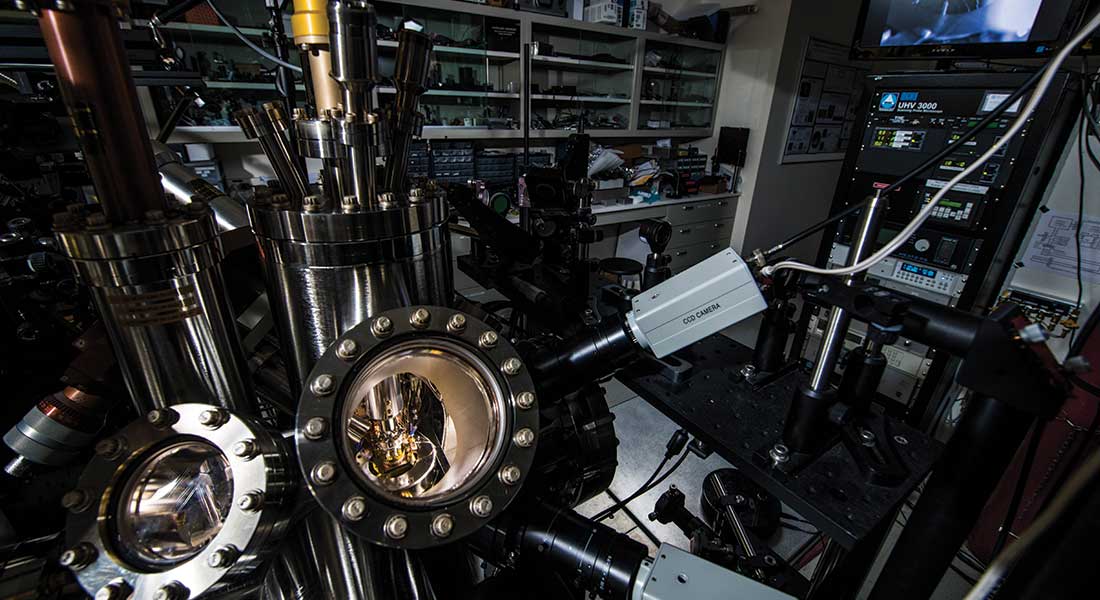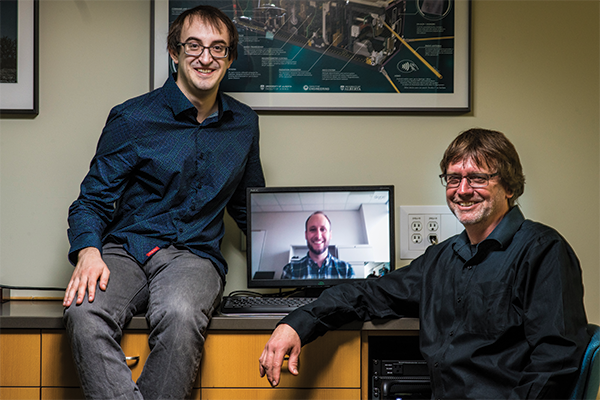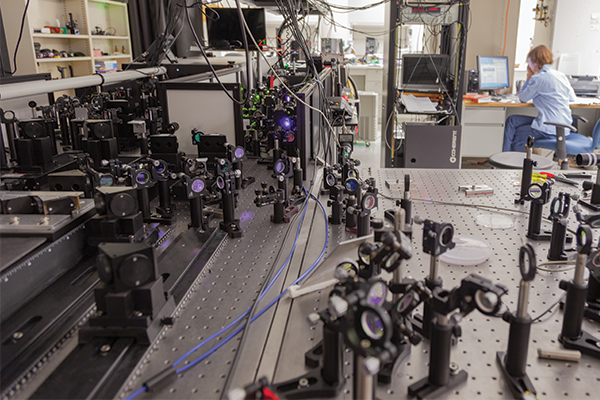
The scanning tunnelling microscope in Frank Hegmann's physics lab is the product of nearly a decade of work and two generations of graduate students.
In 2008, Frank Hegmann opened the door to a new lab in Phase 1 of the Centennial Centre for Interdisciplinary Science, a new underground facility adjacent to the biological sciences building. He was waiting for his new equipment to arrive in hopes of building an apparatus that could take microscopy to the next level. The thing was, he had no idea whether it would work.
Developing a microscope that can take snapshots of electron dynamics inside a single atom has been a longstanding scientific goal. On one hand, researchers could acquire images of single atoms and molecules on surfaces, but not their electronic motion. On the other hand, ultrafast lasers could be used to record the dynamics of many atoms and molecules at once. After years of working on these older systems, Hegmann wondered how he could improve the process.
"I got to thinking, 'What if I could kill the proverbial two birds with one stone?'"
The leading edge technology at the time was the scanning tunnelling microscope (STM). "To actually see single atoms and to manipulate them into structures opened up a whole new world of being able to visualize nature," Hegmann says. "But scanning tunnelling microscopes are not very fast instruments. They can only do slow scans. On the ultra-fast side, there's this whole field of people using these very short laser pulse sources to examine very fast processes in nature."
After joining the University of Alberta as a faculty member, Hegmann eventually applied to the Canadian Foundation for Innovation for a grant to develop an instrument to look at single molecules and even smaller-scale material.
"People were telling me it was risky. We said right in the application that we had no idea if it would work," Hegmann says. "One of the best Christmas presents I ever got was an email from the Research Services Office, just a few days before the holidays, saying that the grant was funded. I couldn't believe it."
Youthful inspiration
Meanwhile at the University of Victoria, an undergraduate student named Tyler Cocker had become fascinated with ultra-fast terahertz technology. He decided to do a master's degree at the University of Alberta with Hegmann.
"As Frank was planning the equipment for this new lab, it became a possibility that I could change into the PhD stream and work with Frank on this idea for a new terahertz STM," says Cocker. "At the time, the lab was an empty room, so this involved some planning. For four years or so, I did terahertz spectroscopy and pre-planning for what we expected to happen when we coupled the terahertz pulses with the STM tip."
Progress on this brand-new, might-not-actually-work technology proved to be anything but a straight path. "There were many moments of discouragement and then elation, and then a point where I would think, 'OK, that's as far as it can go.' And then maybe we need a break, or a pep talk."
Cocker's efforts eventually paid off. "I'm not sure I would have guessed that, as a student working on it, it would get this far so quickly because, at first, it seemed noisy and difficult to do. Now, we can take snapshots of atoms or electron densities around molecules, and it's remarkable."
Next generation
Hegmann made additions to the lab. He bought equipment and recruited researchers, including Vedran Jelic ('12 BSc), who was then a University of Alberta undergraduate looking to do research as a summer student.
"When I started working in the lab with Tyler, the microscope was sitting on the optics bench, which is not really the ideal environment for such a sensitive instrument," Jelic remembers. "After Tyler finished his PhD, our plan was to move the microscope into the ultra-high-vacuum chamber to hopefully study features on the atomic scale. Again, we didn't know if this was going to work, since our model suggested that we might not have enough strength in our laser to see the effect. Thankfully, after a few years of trial and error, we were rewarded with some spectacular results."
Advice from the Terahertz STM lab
The future of condensed matter physics began with an empty room-specifically the lab in which Frank Hegmann (physics) developed the world's first terahertz scanning tunnelling microscope. Now, there is global interest in the terahertz STM from the condensed matter physics community.
Professor Hegmann, soon-to-be post-doctoral fellow Vedran Jelic, and assistant professor Tyler Cocker expect to continue working together, and have some advice for aspiring physicists in the field.
Jelic advises students to be open to the project that they end up working on. "I didn't know what I was getting myself into with terahertz STM. I just sort of dove into it and tried to make the best of it, and it turned out really well in my case." He adds, "There's some persistence to it, too. Just stay on track and trust that the project might work out."
Cocker says, "My advice from being a post-doc would be not to be afraid of trying new things that are a little outside your wheelhouse. You've got a new chance to learn something else new. Take the opportunity to try something out, try something different." He adds: "And choose a good mentor!"
Hegmann's advice to newly hired assistant professors is to hang in there. "The pre-tenure years are quite challenging. There's a lot of work to be done. It is nice when you go into the lab and see some new results, so just take pictures along the way. And enjoy it. Enjoy the little moments. You've got an empty lab space now, and it's not going to be empty for long."
After Cocker went on to a postdoctoral fellowship at University of Regensburg in Germany-where he built the world's second terahertz STM-Jelic stayed at the University of Alberta to complete his PhD while further refining the terahertz STM. The duo will reunite this fall, when Jelic begins a post-doctoral fellowship under Cocker's supervision at Michigan State University, where Cocker was recently hired as an assistant professor of physics.
Together, Cocker and Jelic will be working on what could be the first terahertz STM built in the United States. It would be among at least a dozen other terahertz STMs being developed across the globe.
Hegmann, who years ago couldn't believe he got the initial funding for the project, is amazed by what his team has developed. "The terahertz STM is now a tool that takes an image of what's happening locally-to actually see the energy go from here to here over a few atoms' length scale."
With eyes to the future, terahertz STM may one day revolutionize the speed and efficiency of current technology, ranging from solar cells to computer processing.

